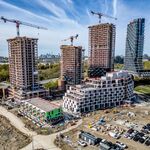W. K. Lis
Superstar
You are safer in a car than on a bike, on foot, or on public transit...NOT.
From WalkBikeCT:
From WalkBikeCT:
The following is an interesting essay by Todd Litman, of the Victoria Transport Policy Institute, reprinted here with the author's permission. Litman quickly debunks the "safety myth", that air-tight excuse you'll so often hear from people who have just used their car for a short trip that they could have easily made on bike, on foot, or, gasp - on the bus. I know this excuse well, it's one I've heard from many a friend, and one I've shamefully employed myself on occasion.
The only real problem with this excuse is that it's not actually true. Driving is not safe. It never was, and it isn't now. Over 40,000 Americans die each year from automobile collisions. Any mode of travel that kills 40,000 people per year cannot rightfully be called "safe".
Take a look at the essay below, and think about it the next time you grab the keys because you just don't feel safe walking to your destination; you might change your mind and decide to hoof it after all.
Most people have a highly distorted view of the risks they face, which distorts their decisions and ultimately reduces their happiness. We live in one of the safest times and places in history, yet, many people live in constant fear, and respond in ways that actually reduce overall security. This is a major obstacle to efficient transportation, healthy living, and livable community.
For example, I recently spoke at a "Philosophy Cafe" (a public discussion of a current issue using philosophical principles) on the theme, "What is the socially optimal level of motor vehicle use?" Because the audience was a thoughtful and progressive, many of them felt obliged to justify their use of automobile travel in situations when they COULD use public transit. The most common excuse: waiting for a bus on a city street is unsafe.
So I asked the audience, how many have had a family member of close friend murdered by a stranger? Only one hesitant hand was raised (it was not a really close friend). Then I asked, how many have had a family member of close friend killed in a car crash? More than half the audience raised their hand. This is statistically representative: for non-poor, middle-age people, the chance of dying in a traffic accident is an order of magnitude greater than the chance of being murdered by a stranger. In fact, the greatest single fatality risk for North Americans in the prime of life (that is, between five and fifty years of age) is dying in a car crash: greater than any disease or being murdered ( http://www.cdc.gov/mmwr/preview/mmwrhtml/mm5550a6.htm and http://www.cdc.gov/nchs/data/nvsr/nvsr53/nvsr53_17.pdf).
North American traffic safety experts tend to misrepresent the issue because they prefer to highlight statistics which imply that their programs are successful. Yes, traffic crash rates per 100 million vehicle-miles have declined significantly during the last fifty years, but this has been offset by increased per capita annual vehicle mileage, so per capita traffic fatality rates declined little, despite huge increases in the use of seatbelts and other safety devices, reductions in drunk driving, improved road and vehicle design, and improved emergency response and medical care. The U.S. has one of the highest per capita traffic fatality rates among developed countries, implying that conventional traffic safety efforts are not very effective, but few traffic safety experts acknowledge this failure.
Another little-recognized fact is that per capita traffic fatality rates are far lower in pedestrian-friendly, transit-oriented, smart growth communities than in conventional, automobile-dependent communities. Automobile oriented suburbs have about four times the traffic fatality rate as smart growth communities. This appears to reflect the combination of increased total driving, higher traffic speeds, and society's inability to withdraw driving privileges to high risk drivers in automobile-dependent communities. All of those families that move to automobile-dependent suburbs to provide a safe and healthy place to raise their children are mistaken: they have actually increased their children's chance of dying a violent death.
These differences are even more significant when viewed from the perspective of society rather than just a single individual, since total traffic fatality rates tend to increase in a community with more per capita motor vehicle travel, while streets and public transit systems become safer as more responsible residents walk, bicycle and ride transit. One of many benefits of shifts from driving to alternative modes is increased safety and security.
Marketing encourages people to consider security just another commodity that we obtain by purchasing supposedly safer travel modes (driving in a large automobile) and locations (purchasing a home in a "quiet" neighborhood). Yet, security is not really something we consume, it is something we create through our own behaviors, by reducing total motor vehicle travel, shifting to alternative modes, and working to increase community cohesion and safety.
For more information see:
Lawrence Frank, Peter O. Engelke and Thomas L. Schmid (2003), Health and Community Design: The Impact Of The Built Environment On Physical Activity, Island Press (www.islandpress.org).
Lawrence Frank, Sarah Kavage and Todd Litman (2006), Promoting Public Health Through Smart Growth: Building Healthier Communities Through Transportation And Land Use Policies, Smart Growth BC (www.smartgrowth.bc.ca); at www.vtpi.org/sgbc_health.pdf.
Howard Frumkin, Lawrence Frank and Richard Jackson (2004), Urban Sprawl and Public Health: Designing, Planning, and Building For Healthier Communities, Island Press (www.islandpress.org).
Peter L. Jacobsen (2003), "Safety In Numbers: More Walkers and Bicyclists, Safer Walking and Bicycling." Injury Prevention (http://ip.bmjjournals.com), Vol. 9, 2003, pp. 205-209; at www.tsc.berkeley.edu/html/newsletter/Spring04/JacobsenPaper.pdf.
Todd Litman and Steven Fitzroy (2006), Safe Travels: Evaluating Mobility Management Traffic Safety Benefits, Victoria Transport Policy Institute (www.vtpi.org); at www.vtpi.org/safetrav.pdf.
William Lucy (2002), Danger in Exurbia: Outer Suburbs More Dangerous Than Cities, University of Virginia (www.virginia.edu); summarized in www.virginia.edu/topnews/releases2002/lucy-april-30-2002.html.
Robert Noland (2003), "Traffic Fatalities and Injuries: The Effects of Changes in Infrastructure and Other Trends," Journal of Accident Prevention and Analysis, Vol. 35, pp. 599-611; at www.cts.cv.ic.ac.uk/staff/wp22-noland.pdf.
VTPI (2008), "Address Security Concerns" ( http://www.vtpi.org/tdm/tdm37.htm ), Online TDM Encyclopedia ( http://www.vtpi.org/tdm ).







